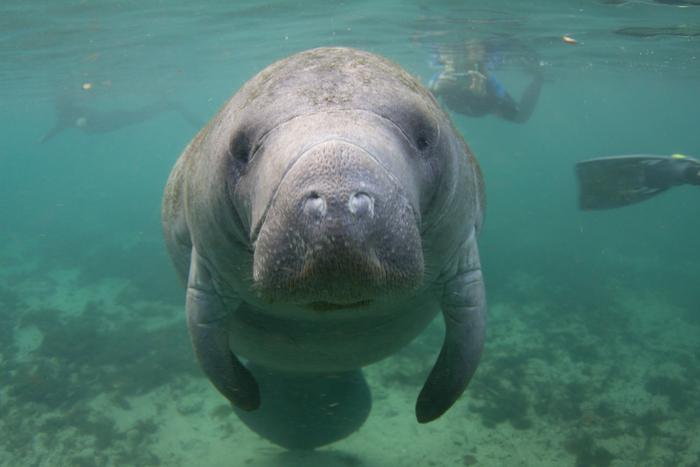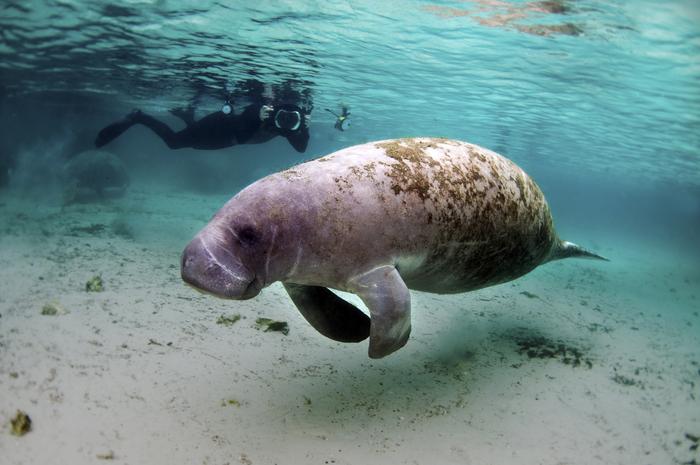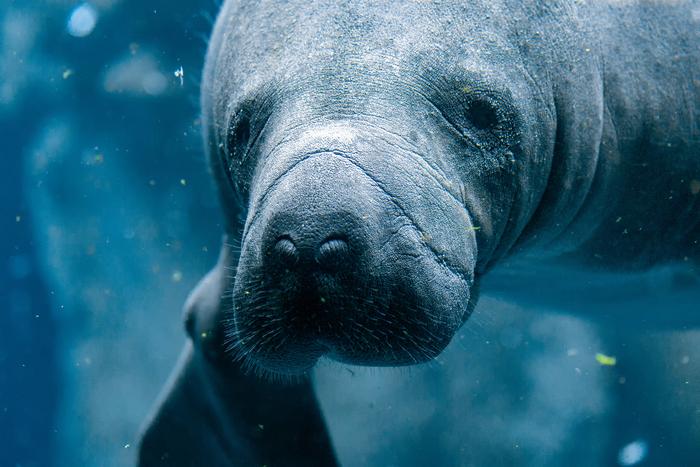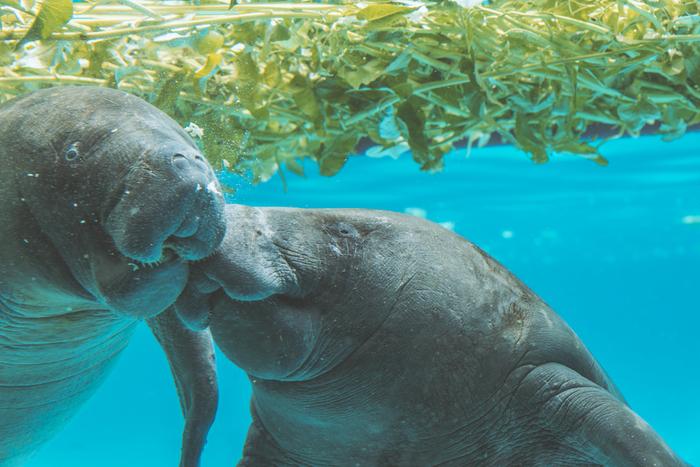Manatees are rather large, but they’re actually quite cute and cuddly looking. Manatees are some of our favorite animals and these manatee facts prove why!
They have such a peaceful and calm nature, they love warm water, and they spend most of their day eating – what’s not to love?!
Read these facts about manatees to find out what else makes them so interesting.
This post may contain affiliate links. Please see our disclosure.

15 Manatee Facts
1. Manatees are the teddy bears of the sea.
These roly-poly teddy bears clock in at 9 to 13 feet long and typically anywhere from 1000 to 1300 pounds.
They have two forelimb flippers that they use for steering movements and also to hold their yummy food while eating.
2. There are three species of manatee.
All three species of manatee – the Amazonian manatee, West Indian manatee, and West African manatee – are considered vulnerable by the IUCN Red List of Threatened Species.
This is mostly due to the variety of threats to them, including boat collisions, hunting, habitat destruction, and toxic red tides.
The West Indian manatee (Trichechus manatus) and West African manatee (T. senegalensis) spend their lives on the cusp between salt and fresh water.
It is believed that the West Indian manatee requires access to freshwater to stay hydrated, but they easily move between the two.
Warm water, usually 60 degrees or warmer, is a must for both West Indian and West African manatees due to their low metabolic rates and minimal fat protection.
That’s why in colder months, they make their way to warmer rivers and springs in Florida.
Meanwhile, the Amazonian manatee (Trichechus inunguis) lives entirely in freshwater rivers throughout South America in the Amazon Basin.

3. Manatees are herbivores.
Manatees are typically found in shallow coastal areas and rivers grazing on sea grass, mangrove leaves, and algae.
Manatees eat for almost half of their day, putting away approximately 10 percent of their body weight in plants each and every day.
Also known as “sea cows,” manatees are the largest ocean herbivore.
4. The elephant is the closest living relative to manatees.
Manatees evolved from the same land animals as elephants over 50 million years ago, meaning they share a common ancestor.
They have many things in common, including their uncommon-shaped hearts, their thick, gray skin with very sparse hair, their herbivorous diets, and more.
5. Crystal River in Florida is the “Manatee Capitol of the World.”
Crystal River is known as the “Manatee Capitol of the World” or the “Home of the Manatee.”
Only in the waters of Citrus County are you able to legally swim with manatees.

6. Manatees were once mistaken for mermaids.
Early explorers, including Christopher Columbus, claimed to have seen female figures swimming in the ocean (aka mermaids).
We now know these encounters were actually manatees.
7. Manatees have no natural predators.
In the wild, manatees have no natural predators. Unfortunately, humans have played a large role in pushing all three species to the risk of extinction.
About half of West Indian manatee deaths are caused by humans, mostly by boat collisions. Another big human-created issue is nutrient runoff from factory farming.
That aside, manatees can live long lives, with natural lifespans of 60 years or more.
8. They grow new teeth constantly.
Unlike humans, manatees can grow new teeth throughout their lives.
Their teeth get withered down over time before they completely fall out. Then new molars grow (they only have molars!).
9. Algae grows on their skin.
Not only do manatees eat algae, but algae also grows on their skin. This is mostly due to the fact that they come up for air and move really slow and algae grows best in wet and sunny areas.
This is a symbiotic relationship, of course, and the algae helps protect the manatees from harmful sun rays.
10. Manatees swim very slowly.
Manatees swim at only 3 to 5 miles per hour. They can reach up to 20 miles per hour, but only for a short time.
Even though they’re slow, they travel about 40 to 50 miles every day.
And while they may move slowly, they’re actually very agile.
They can swim vertically, upside down, barrel roll, and even do somersaults!
11. Manatees can hold their breath for up to 20 minutes.
While manatees can hold their breath for up to 20 minutes, they often go to the surface every three to five minutes.
When they do take a breath, 90 percent of the air in their lungs is replaced. In comparison, humans tend to replace about 10 percent.
12. Proportionally, manatees have the smallest brains of any mammal.
Unlike our brains that have “folds,” manatees’ brains are actually smooth. Additionally, the ratio of their brain to body size is the lowest of any mammal.
Regardless, manatees can learn basic tasks, are very sensitive to touch, and can differentiate colors.

13. Manatees breed slowly.
A female manatee (cow) is pregnant for an entire year. The baby manatee (calf) stays with its mother and nurses for up to two years.
Manatees only produce young every two to five years, another reason why it’s important to keep them protected.
14. Manatees are protected by law.
The main thing to know about manatees – look don’t touch.
Any sort of harassment, even hugging manatees, is illegal.
Manatees are protected by the Marine Mammal Protection Act (MMPA). Enacted in 1972, the MMPA ensures that threatened species like manatees are not to be taken from their natural habitats.
15. November is Manatee Awareness Month.
November is Manatee Awareness Month! It’s an annual month-long dedication to manatees and their conservation in Florida and beyond. Time to share these manatee facts with everyone!
Former Florida Governor Bob Graham declared November as Manatee Awareness Month in 1979, when the state began designating manatee protection zones. November is also typically when manatees return to Florida’s warmer waters from their summer migratory routes.
Get involved with organizations like Save the Manatee to help these gentle giants.
- Believe In Aliens? Visit These 7 Out Of This World Places - April 27, 2024
- 9 Weird Things To Do In Dublin, Ireland - April 13, 2024
- 14 Weird Things To Do In Indianapolis, Indiana - April 13, 2024




